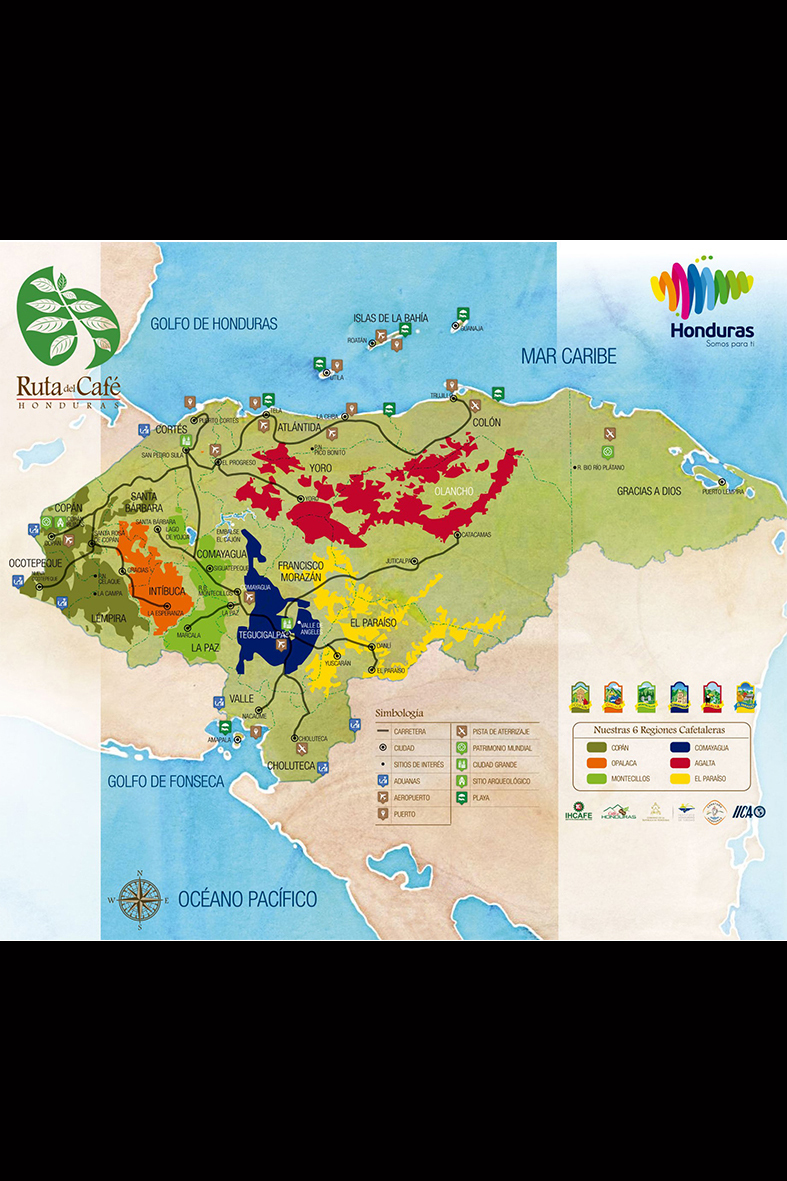

HONDURAS
Coffee has historically been one of Honduras’ leading exports (alongside bananas), and since the mid-2,000s total annual production has grown in leaps and bounds. During the 2009/10 crop year, Honduras produced approximately 3.6 million bags of Arabica coffee (already a big increase over 1999/2000). By 2014/2015, the country had become Central America’s top grower (and number 7 in the world), with a yield of over 5 million bags (all Arabica varietals). With the highest production per capita in the world and various business drivers keeping the industry growing, experts agree that it wouldn’t be surprising for the country to reach 8 million bags in the foreseeable future. All in all, the story is clear: Honduras is a big coffee producing country with a lot of untapped potential for specialty lots and micro-lots.
Today, more than 100,000 families across Honduras are involved in coffee production. 95% of these are small-scale farmers and 70% farm on fewer than 2 hectares (representing some 30% of the country’s total production). The vast majority of farmers (95% or more) rely on family labour (including their own children) for all aspects of agricultural and harvest labour.
In addition to internal and external promotion, Hondura’s IHCAFE (Instituto hondureño del café) offers technical assistance and training to farmers, helps with establishing nurseries and greenhouses, has established innovative pest management and early warning systems. In 2004 it helped to set up a national cupping school, which provides comprehensive training for cuppers and gives young people the opportunity to build a career in coffee quality control.
Honduras has been divided into six well-defined regions. Each region has its own IHCAFE-sponsored cupping lab, which offers farmers a free cupping service. These six main regions are in turn split into various micro regions, demarcated by geography and cup profiles.
Copán (north-west, bordering Guatemala and El Salvador)
1,000 - 1,500 metres above sea level
Harvest Season: November - March
Varieties: Bourbon, Caturra, Catuai
Marcala-Montecillos (south-west)
1,200 - 1,600 metres above sea level
Harvest Season: December – April
Varieties: Bourbon, Catuai, Caturra, Pacas
Opalca (north-west)
1,100 – 1,500 metres above sea level
Harvest Season: November – February
Varieties: Bourbon, Catuai, Typica
Agalta Tropical (north and east)
1,300 - 1,950 metres above sea level
Harvest Season: December – March
Varieties: Bourbon, Caturra, Typica
Comayagua (centre-west)
1,000 - 1,500 metres above sea level
Harvest Season: December – March
Varieties: Bourbon, Caturra, Typica
El Paraíso (south-east)
950 - 1,950 metres above sea level
Harvest Season: December – March
Varieties: Catuai, Caturra
Today, more than 100,000 families across Honduras are involved in coffee production. 95% of these are small-scale farmers and 70% farm on fewer than 2 hectares (representing some 30% of the country’s total production). The vast majority of farmers (95% or more) rely on family labour (including their own children) for all aspects of agricultural and harvest labour.
In addition to internal and external promotion, Hondura’s IHCAFE (Instituto hondureño del café) offers technical assistance and training to farmers, helps with establishing nurseries and greenhouses, has established innovative pest management and early warning systems. In 2004 it helped to set up a national cupping school, which provides comprehensive training for cuppers and gives young people the opportunity to build a career in coffee quality control.
Honduras has been divided into six well-defined regions. Each region has its own IHCAFE-sponsored cupping lab, which offers farmers a free cupping service. These six main regions are in turn split into various micro regions, demarcated by geography and cup profiles.
Copán (north-west, bordering Guatemala and El Salvador)
1,000 - 1,500 metres above sea level
Harvest Season: November - March
Varieties: Bourbon, Caturra, Catuai
Marcala-Montecillos (south-west)
1,200 - 1,600 metres above sea level
Harvest Season: December – April
Varieties: Bourbon, Catuai, Caturra, Pacas
Opalca (north-west)
1,100 – 1,500 metres above sea level
Harvest Season: November – February
Varieties: Bourbon, Catuai, Typica
Agalta Tropical (north and east)
1,300 - 1,950 metres above sea level
Harvest Season: December – March
Varieties: Bourbon, Caturra, Typica
Comayagua (centre-west)
1,000 - 1,500 metres above sea level
Harvest Season: December – March
Varieties: Bourbon, Caturra, Typica
El Paraíso (south-east)
950 - 1,950 metres above sea level
Harvest Season: December – March
Varieties: Catuai, Caturra
-
Mikael Ljungren
- coffee@pezoimport.com
- +46 728 974 772
-
Ronald Rengifo
- ronald@pezoimport.com
- +46 760 461 860 (whatsapp)
Interested in an offer?
If you would like to know more about Pezo Import’s range of coffee cooperative partners, receive a sample of coffee for cupping or have special requirements in terms of quality, region, size or other, we would be delighted to hear from you.Pezo Import AB
Sweden:Address: Hyllie Boulevard 34, 21532 Malmo - Sweden.
Reg. nr. 559018-6523
VAT: SE559018652301
P.R China:
Guangzhou Pezo Coffee Trading Co., Ltd. ( 广州必诺咖啡贸易有限公司 )
Address: Room 1296, 12th Floor, Tower A, G.T.Land, No.85 Huacheng Avenue, Tianhe, 510623, Guangzhou, Guangdong, P.R.China.
Angola:
Southern Coffee Comercio Ltda.
Belas Business Park, Edificio Cuanza Sul, 6F. Luanda, Luanda - Angola.
NIF: 5001749730 - Tlf: +244 948611381